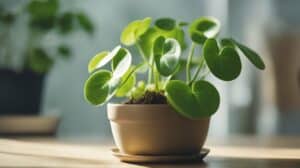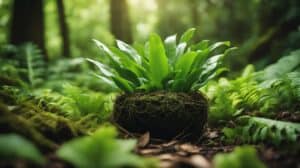The Bottle Palm (Hyophorbe lagenicaulis) is a unique tree that is native to the Mascarene Islands of the Indian Ocean. Its distinctive shape and size make it a popular choice for landscaping and gardening enthusiasts. However, propagating this plant can be a bit challenging, and it requires a specific set of conditions to thrive.

To successfully propagate Bottle Palms, it is essential to understand their growth cycle and unique needs. This article will explore the secrets to propagating Bottle Palms, including the ideal growing conditions and methods for starting new plants. Whether you are a seasoned gardener or a beginner, this guide will provide you with the knowledge you need to grow and propagate Bottle Palms successfully.
Understanding the Bottle Palm
Species Overview
The Bottle Palm (Hyophorbe lagenicaulis) is a unique and charming palm tree that is native to the Mascarene Islands in the Indian Ocean. It is also known as the Bottle Tree Palm or the Palmiste Bouteille. The tree gets its name from its distinct bottle-shaped trunk, which is swollen at the base and tapers upwards.
The Bottle Palm is a slow-growing tree that can reach a height of up to 10 feet (3 meters) in ideal conditions. It has a single, unbranched stem that is topped with a crown of feathery, pinnate leaves that can grow up to 10 feet (3 meters) long. The tree produces small, yellowish flowers that are followed by small, red fruits that are about the size of a cherry.
Growth Characteristics
The Bottle Palm is a tropical tree that thrives in warm, humid climates. It prefers well-drained soil and can tolerate drought conditions once established. The tree is not frost-tolerant and should be grown in areas that do not experience freezing temperatures.
Propagation of the Bottle Palm can be done by seed or by division of the suckers that grow at the base of the tree. Seeds should be planted in well-draining soil and kept moist until germination occurs. Suckers can be removed from the parent tree and planted in their own containers or directly in the ground.
The Bottle Palm is a low-maintenance tree that requires little pruning or care once established. It is a popular choice for landscaping in tropical and subtropical regions due to its unique shape and attractive foliage.
Propagation Basics

Seed Collection and Preparation
Bottle palm seeds should be collected when they are ripe, which is typically in the fall. Look for seeds that have turned a dark brown color and have fallen off the tree. Once collected, the seeds should be cleaned and dried for a few days before planting.
To prepare the seeds for planting, it’s recommended to remove the outer layer of the seed, which can be done by gently rubbing the seed with sandpaper or a nail file. This will help the seed to absorb water more easily and increase the chances of successful germination.
Germination Conditions
Bottle palm seeds require warm and moist conditions to germinate. It’s recommended to plant the seeds in a well-draining potting mix and keep the soil consistently moist. Covering the pot with plastic wrap or a clear plastic bag can help to maintain humidity levels and increase the chances of successful germination.
It’s important to keep the seeds warm, with temperatures between 75-85°F (24-29°C) being ideal. A heat mat can be used to provide consistent warmth if needed.
Germination can take anywhere from 2-6 months, so patience is key when propagating bottle palms from seed. Once the seedlings have emerged, they should be gradually acclimated to brighter light and less humidity before being transplanted into their permanent location.
Planting and Aftercare

Soil and Potting
When planting bottle palm, it is important to use well-draining soil that is rich in organic matter. A mixture of peat moss, perlite, and sand can be used to create a suitable growing medium. The pot should have drainage holes to avoid waterlogging. Adding a layer of gravel at the bottom of the pot can also help with drainage.
Watering and Fertilization
Bottle palm requires regular watering, especially during the growing season. It is important to keep the soil moist but not waterlogged. Overwatering can lead to root rot and other problems. Fertilizer should be applied every two to three months during the growing season. A balanced fertilizer with equal parts nitrogen, phosphorus, and potassium can be used.
Transplanting Tips
When transplanting bottle palm, it is important to be gentle with the roots. The plant should be lifted from the pot and placed in a new pot with fresh soil. The new pot should be slightly larger than the old one to allow for growth. The plant should be watered well after transplanting and placed in a shady spot for a few days to allow it to recover from the shock of transplanting.
Overall, bottle palm is a relatively easy plant to care for with proper planting and aftercare techniques. With the right soil, watering, and fertilization, the plant can thrive and add a touch of island charm to any garden or landscape.
Frequently Asked Questions

What are the best conditions for germinating bottle palm seeds?
Bottle palm seeds require warm and humid conditions to germinate successfully. The ideal temperature for germination is around 80°F (27°C), with high humidity levels of at least 80%. It’s recommended to plant the seeds in well-draining soil and keep the soil consistently moist but not waterlogged.
Can you propagate a bottle palm using cuttings, and if so, how?
Bottle palms cannot be propagated using cuttings as they do not produce suckers. The only way to propagate a bottle palm is through seed germination.
What is the average growth rate of a bottle palm per year?
The average growth rate of a bottle palm is relatively slow, typically around 6-12 inches (15-30 cm) per year. However, this can vary depending on the growing conditions, such as temperature, humidity, and soil quality.
How should bottle palms be pruned for optimal growth?
Bottle palms do not require pruning unless there are dead or damaged fronds that need to be removed. It’s important to avoid over-pruning, as this can stunt the growth of the tree.
What common diseases affect bottle palms and how can they be treated?
Bottle palms are relatively disease-resistant, but they can be susceptible to fungal infections such as leaf spot and root rot. To prevent these diseases, it’s important to avoid overwatering and ensure proper drainage. If a fungal infection does occur, it’s recommended to treat the affected area with a fungicide.
What hardiness zones are suitable for growing bottle palms?
Bottle palms are native to tropical regions and are only suitable for growing in USDA hardiness zones 10-11. In colder climates, they can be grown in containers and brought indoors during the winter months.












